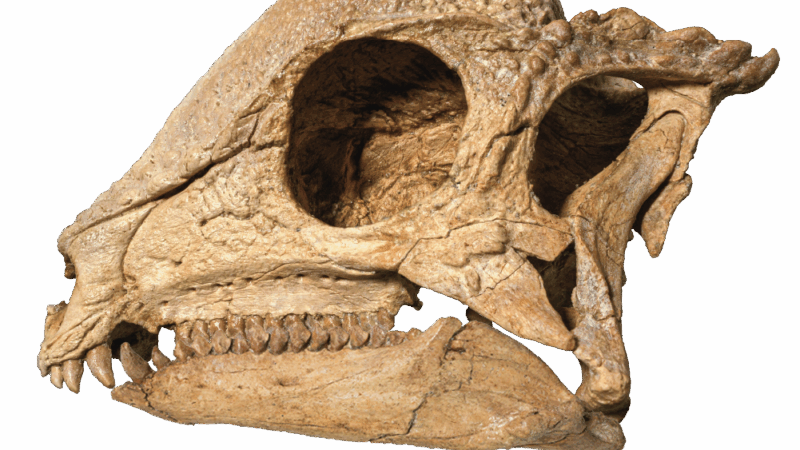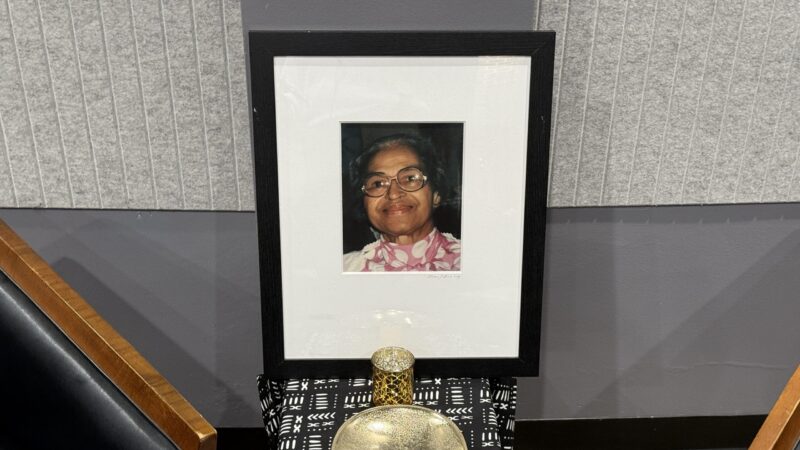This ‘magical’ dinosaur specimen emerged from the ground like a polished jewel
It was a cloudy morning in southeast Mongolia. Paleontologist Chinzorig Tsogtbaatar and several colleagues set out by foot from their campsite to a rocky outcrop dating back some 110 million years to the early Cretaceous.
“Then, after 15 to 20 minutes, I saw something [on the] other side of the hill,” says Tsogtbaatar. It was a bright object of some sort. “It [didn’t] look like a rock,” he recalls. “It [was] very unusual.”
Once he got closer, Tsogtbaatar — who now works at North Carolina State University — knew exactly what it was. A dome-shaped skull. It turned out that Tsogtbaatar had just discovered a new species of pachycephalosaur, a unique group of dinosaurs defined by their thick, bony, hemispherical skulls but about which little else is known.

In that moment, “we just stopped breathing,” he says.
“This is the first definitive pachycephalosaur that’s ever been found in the early Cretaceous,” says Lindsay Zanno, also a paleontologist at North Carolina State University in addition to serving as the head of paleontology at the North Carolina Museum of Natural Sciences. “It just pops out of the fossil record with a fully developed dome, and bells and whistles on its head.”
Tsogtbaatar, Zanno, and their colleagues have introduced the world to this new species in a paper published in the journal Nature. They gave it the scientific name Zavacephale rinpoche. The word rinpoche is Tibetan for “precious one” and refers to the domed skull, which appeared out of the rockface to Tsogtbaatar that June morning like a perfectly polished jewel.
Bones of enchantment
The new specimen is 15 million years older than what had previously been the oldest pachycephalosaur ever found. “So this dinosaur fills in a critical gap in the early evolution of this famous group of dome-headed dinosaurs,” says David Evans, a dinosaur paleontologist at the Royal Ontario Museum in Toronto who wasn’t involved in the research.
After its excavation in 2019, the fossil stayed in Mongolia during the pandemic. Finally, in 2022, it was shipped to North Carolina for additional analysis. Zanno says the moment she first laid eyes on it, she was “enchanted.”
“Everyone just stood around the lab just holding this precious, incredible skull,” she says. “It’s just the most beautiful specimen. It’s magical.”
That domed head — made of solid bone and edged in spikes — is any pachycephalosaur’s most distinguishing feature.
“Their domes are essentially indestructible,” says Zanno. “It would have been able to protect the skull against pressure or impact. And so we think that these animals were battling it out with their heads.”
Still, researchers have known relatively little about these plant-eaters because most of the rest of their bodies haven’t been found. So when the team in Mongolia went on to excavate dozens more bones from Zavacephale rinpoche, it became the most complete pachycephalosaur skeleton ever to be unearthed.
“It’s about the size of a German shepherd,” says Zanno, “but you have to remember 75% of the body is a neck and a tail, so they’re very light. It would have only weighed about 12 pounds.”
A juvenile jewel
This little fossil has already revealed a few new insights. The stomach contained small stones that would have helped the animal digest its food. The tail is shot through with bony tendons, which would have made it more rigid.
Plus, this was the first time a pachycephalosaur’s hand bones had ever been found. “At first, we thought it was something it ingested instead of parts of its own body. That’s how tiny its hands were,” says Zanno.
In addition, the limb bones allowed the researchers to determine the age of the dinosaur. It was at least two years old, making it a juvenile. This shows that young pachycephalosaurs like this one already had fully developed domes.
“Whether they were battling it out for territory or mates is something we’re not entirely sure of,” says Zanno, “but what’s clear is that whatever they were doing with those domes, they started practicing at a very young age.”
The specimen is now back home at the Institute of Paleontology of the Mongolian Academy of Sciences as part of the country’s mission to protect its natural and cultural heritage.
Cary Woodruff, a curator of vertebrate paleontology at the Frost Museum of Science in Miami who wasn’t involved in the study, said he was floored by the discovery — and that his surprise was mixed with a dash of “very friendly jealousy.”
“How he even found the specimen is just bonkers,” Woodruff said of Tsogtbaatar. “He doesn’t just find a new one. He doesn’t just find the geologically oldest one. He finds [what] everyone who works on pachycephalosaurs has always wanted to find.”
Evans was similarly impressed. “I was just stunned by the beauty and completeness of this particular fossil,” he says. “This is a specimen that we’ll be learning from for many, many years to come.”
Woodruff is also confident that this fossil will spawn new ideas about how pachycephalosaurs once lived. He says usually paleontologists have to work with very incomplete skeletons. “In our mind, we can see, we can imagine what the rest of it looked like,” Woodruff says. “But you didn’t have to imagine anything with a specimen like this. It was [all] there. The teeth are literally smiling at you.”
Transcript:
ANDREW LIMBONG, HOST:
The pachycephalosaurs were a unique group of dinosaurs with domed heads, but scientists haven’t known much about them because their fossils have been so incomplete until now. Science reporter Ari Daniel describes a stunning discovery from southern Mongolia.
ARI DANIEL, BYLINE: It was a cloudy morning in June 2019, when paleontologist Chinzorig Tsogtbaatar and several colleagues set out by foot from their campsite to a rocky outcrop dating back about 110 million years to the early Cretaceous.
CHINZORIG TSOGTBAATAR: Then after 15 to 20 minutes, I saw something in other side of the hill.
DANIEL: A bright object of some sort.
TSOGTBAATAR: It wasn’t looked like a frog – very unusual. Then I want to go down to check.
DANIEL: Once he got closer, Tsogtbaatar, who now works at North Carolina State University, knew exactly what it was.
TSOGTBAATAR: It was a skull.
DANIEL: And not just any skull. It was dome shaped. Tsogtbaatar had just discovered a new species of pachycephalosaur.
TSOGTBAATAR: We just stopped breathing.
LINDSAY ZANNO: So this is the first definitive pachycephalosaur that’s ever been found in the early Cretaceous.
DANIEL: Meaning it’s 15 million years older than what had been the oldest pachycephalosaur, says Lindsay Zanno, also a paleontologist at NC State. This specimen fills in a crucial gap in the early evolution of this group of dinos. Zanno remembers the moment she first laid eyes on it.
ZANNO: I mean, everyone just stood around the lab just holding this precious, incredible skull. Everyone is enchanted. It’s just the most beautiful specimen.
DANIEL: That domed head made of solid bone and edged in spikes is any pachycephalosaur’s most distinguishing feature.
ZANNO: Their domes are essentially indestructible. It would have been able to protect the skull against pressure or impact. And so we think that these animals were battling it out with their heads.
DANIEL: Still, researchers have known relatively little about these plant eaters. That’s because most of the rest of their bodies haven’t been found. So when the team in Mongolia went on to excavate dozens more bones from that new animal, it became the most complete pachycephalosaur skeleton ever to be unearthed.
ZANNO: It’s about the size of a German shepherd. But you have to remember, 75% of the body is a neck and a tail, so they’re very light, at about 12 pounds.
DANIEL: This little fossil has already revealed a couple insights. For instance, this was the first time the hand bones of a pachycephalosaur were found, and they were super small.
ZANNO: We thought it was something it ingested instead of parts of its own body. That’s how tiny its hands were.
DANIEL: In addition, the limb bones allowed the researchers to age the dinosaur. It was at least 2 years old, a juvenile, meaning that young pachycephalosaurs like this one already had a fully developed dome.
ZANNO: Whether they were battling it out for territory or mates is something we’re not entirely sure of, but whatever they were doing with those domes, they started practicing at a very young age.
DANIEL: The research is published in the journal Nature. Cary Woodruff is the curator of vertebrate paleontology at the Frost Museum of Science in Miami and wasn’t involved in the discovery. He says usually, paleontologists have to work with very incomplete skeletons.
CARY WOODRUFF: In our mind, we can see, we can imagine, like, what the rest of it looked like. But you didn’t have to imagine anything with a specimen like this. It was there, right? The teeth are literally smiling at you.
DANIEL: Woodruff is confident this fossil will spawn new ideas about how pachycephalosaurs once lived. Meanwhile, the specimen’s back home in Mongolia, and the new species has a new scientific name that Chinzorig Tsogtbaatar bestowed.
TSOGTBAATAR: Zavacephale rinpoche.
DANIEL: That second word, rinpoche, is Tibetan for precious one and refers to the domed skull, which appeared out of the rock face to Tsogtbaatar like a perfectly polished jewel. For NPR News, I’m Ari Daniel.
(SOUNDBITE OF FOUR TET’S “AS SERIOUS AS YOUR LIFE”)
A family reunion to commemorate the Montgomery Bus Boycott
This month marked the 70th anniversary of the historic Montgomery Bus Boycott. The demonstration was catalyzed when Rosa Parks refused to give up her seat on a bus. The boycott lasted over a year and is considered a spark of the Civil Rights Movement.
President Trump to add his own name to the Kennedy Center
The arts institution will be called the Trump-Kennedy Center. The president's press secretary said it comes after a unanimous vote by the center's board, which Trump took over earlier this year.
Mangione pre-trial hearing wraps, but judge won’t rule on evidence for months
After three weeks of testimony, a judge will now rule on whether evidence found in Mangione's backpack can be used in his state trial for the murder of UnitedHealthcare CEO Brian Thompson.
Lucy Liu on ‘Rosemead,’ rejection and returning to Mandarin
The child of Chinese immigrants, Liu didn't learn English until she was 5. She plays a terminally ill woman grappling with her teenage son's mental health crisis in Rosemead.
Mariah Carey’s ‘All I Want for Christmas Is You’ breaks an all-time chart record
With Carey's enduring Christmas hit, we may be looking at a record that borders on the untouchable.
Austrian nuns await word from the Vatican on whether they can stay in their convent
The three octogenarian nuns broke out of a nursing home to go back to live in their convent, sparking a dispute with their church superior. Both sides have appealed to the Vatican for a resolution.









